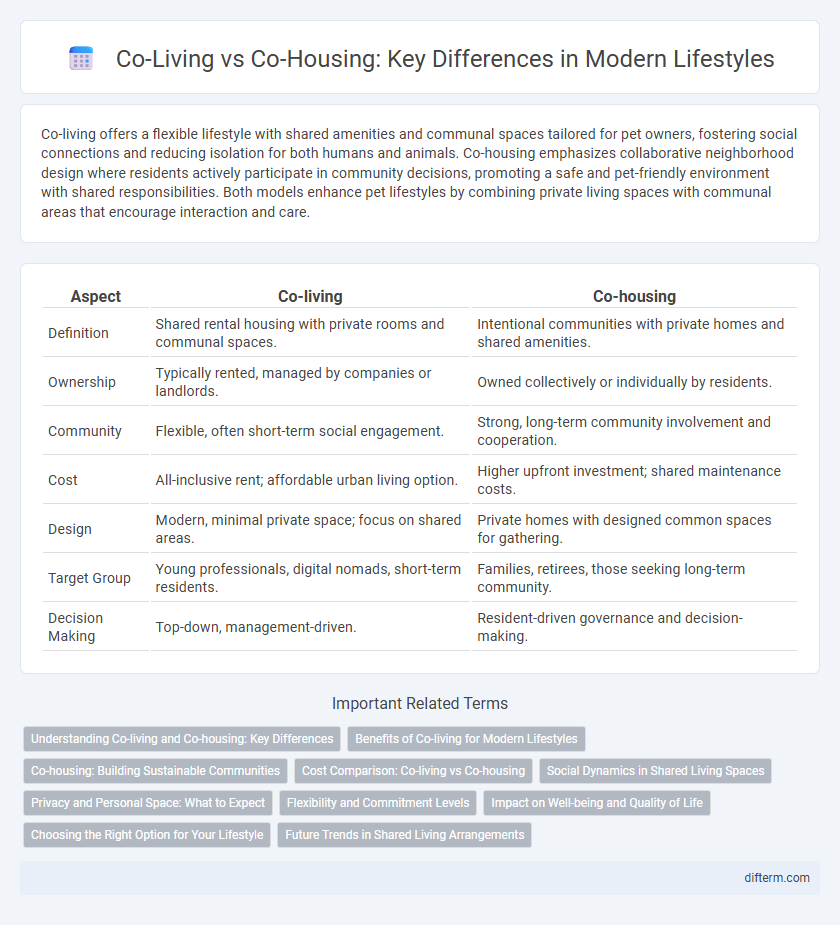Co-living offers a flexible lifestyle with shared amenities and communal spaces tailored for pet owners, fostering social connections and reducing isolation for both humans and animals. Co-housing emphasizes collaborative neighborhood design where residents actively participate in community decisions, promoting a safe and pet-friendly environment with shared responsibilities. Both models enhance pet lifestyles by combining private living spaces with communal areas that encourage interaction and care.
Table of Comparison
| Aspect | Co-living | Co-housing |
|---|---|---|
| Definition | Shared rental housing with private rooms and communal spaces. | Intentional communities with private homes and shared amenities. |
| Ownership | Typically rented, managed by companies or landlords. | Owned collectively or individually by residents. |
| Community | Flexible, often short-term social engagement. | Strong, long-term community involvement and cooperation. |
| Cost | All-inclusive rent; affordable urban living option. | Higher upfront investment; shared maintenance costs. |
| Design | Modern, minimal private space; focus on shared areas. | Private homes with designed common spaces for gathering. |
| Target Group | Young professionals, digital nomads, short-term residents. | Families, retirees, those seeking long-term community. |
| Decision Making | Top-down, management-driven. | Resident-driven governance and decision-making. |
Understanding Co-living and Co-housing: Key Differences
Co-living involves shared housing with private bedrooms and communal common areas designed for flexibility and convenience, often targeting young professionals or digital nomads. Co-housing emphasizes intentional communities where residents actively participate in planning and managing shared spaces, fostering strong social connections and sustainability. Understanding these differences highlights co-living's convenience and co-housing's community-driven lifestyle as distinct approaches to collaborative living.
Benefits of Co-living for Modern Lifestyles
Co-living offers flexible, community-centric housing solutions tailored for modern lifestyles, enabling residents to share amenities and foster social connections while maintaining personal privacy. It reduces housing costs through shared expenses and provides adaptable lease terms ideal for urban professionals and remote workers. Access to curated communal experiences enhances well-being and supports a collaborative environment that aligns with contemporary urban living trends.
Co-housing: Building Sustainable Communities
Co-housing emphasizes intentional neighborhoods where residents actively participate in shared spaces and resources, fostering strong social connections and environmental responsibility. Sustainable design principles, such as energy-efficient buildings, communal gardens, and renewable energy systems, are integral to co-housing developments. This model promotes long-term community resilience and reduces ecological footprints compared to traditional housing.
Cost Comparison: Co-living vs Co-housing
Co-living typically offers lower upfront costs and flexible lease terms, making it more affordable for young professionals and digital nomads. Co-housing, while requiring higher initial investments due to shared property ownership and long-term commitments, often results in lower monthly expenses through shared maintenance and utilities. Evaluating cost efficiency depends on individual financial goals, with co-living favoring short-term affordability and co-housing emphasizing long-term savings.
Social Dynamics in Shared Living Spaces
Co-living spaces emphasize flexible, short-term social interactions with a focus on community events and shared amenities that foster casual connections among residents. In contrast, co-housing communities prioritize long-term relationships through collaborative decision-making and shared responsibilities, creating a strong sense of neighborhood and mutual support. Both models enhance social dynamics by encouraging interaction, but co-housing typically offers deeper, more sustained social bonds due to intentional community design.
Privacy and Personal Space: What to Expect
Co-living spaces typically offer private bedrooms with shared common areas, balancing social interaction and personal privacy, whereas co-housing communities emphasize individual homes clustered around shared facilities, providing greater personal space and autonomy. Residents in co-housing often experience enhanced privacy through dedicated living quarters and self-contained units, while co-living arrangements may require adaptation to more communal living dynamics. Understanding these differences helps individuals choose the right environment based on their privacy preferences and lifestyle needs.
Flexibility and Commitment Levels
Co-living offers greater flexibility with shorter lease terms and fully furnished spaces, appealing to individuals seeking temporary or transitional living arrangements. Co-housing involves long-term commitment through ownership or cooperative agreements, fostering a stable community environment with shared responsibilities. Flexibility in co-living supports dynamic lifestyles, while co-housing prioritizes permanence and deeper social integration.
Impact on Well-being and Quality of Life
Co-living spaces promote social interaction and flexibility, enhancing mental health by reducing loneliness and fostering community support. Co-housing communities offer more stability and shared responsibility, contributing to a stronger sense of belonging and improved overall well-being. Both models positively influence quality of life through collaborative living but differ in their approaches to privacy and communal engagement.
Choosing the Right Option for Your Lifestyle
Co-living offers flexible, fully furnished spaces ideal for short-term stays and social interactions, appealing to young professionals and digital nomads seeking community convenience. Co-housing provides long-term, ownership-based shared communities with private homes and collaborative spaces, suited for families and individuals aiming for sustainable living and deeper neighborhood connections. Evaluating factors such as commitment level, privacy needs, and community involvement helps determine the best fit between co-living and co-housing for your lifestyle.
Future Trends in Shared Living Arrangements
Co-living spaces emphasize flexible, community-focused urban lifestyles with shared amenities and short-term leases, catering to young professionals and digital nomads seeking affordability and social interaction. Co-housing promotes long-term, intentional communities often designed around sustainability and mutual support, appealing to families and retirees prioritizing stability and collaboration. Future trends indicate a blend of technology integration, such as smart home systems and app-based community management, with increasing demand for eco-friendly designs and customizable shared environments.
Co-living vs Co-housing Infographic

 difterm.com
difterm.com